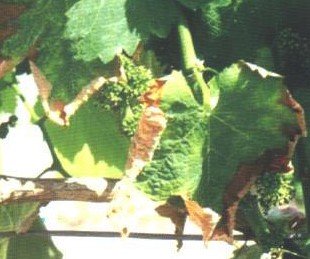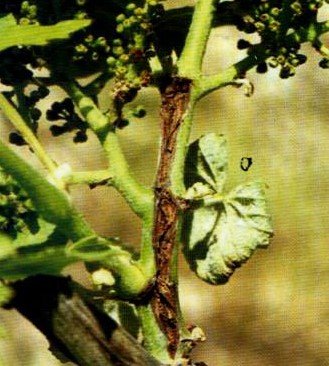Bacterial necrosis currently affects five winegrowing regions: Roussillon, Armagnac (Aquitaine and Midi-Pyrénées), Charentes and Diois, i.e. 67 known communes and nine appellations. However, this list is not exhaustive, as the disease is not always correctly identified by winegrowers.
2.4.2.h Bacterial Necrosis
What damage is caused by bacterial necrosis in the vineyard?
- Buds: no budburst or desiccation at 2-3 leaf stage
- Leaves: in the case of contamination through the vessels, the leaves show sectorial drying of leaf blades to a tan colour. These leaves become completely discoloured and drop off. In the case of contamination of the parenchyma, the leaves develop small brown or blackish polygonal spots surrounded by a yellow oily halo.
-
Shoots and branches: after the 4-5 leaf stage, brown linear spots with an oily-looking border may appear, which evolve into a canker by bursting or merithalles forming a deep brown or black crevice depending on the grape variety. The most affected vines have stunted vegetation.
-
Inflorescences and clusters: blackening of flower buds and shatter is observed, and the stems may burst.
Can it be confused with other diseases?
It is possible to confuse it with, for example, frost or hail damage, symptoms of excoriosis, eutypiosis or even downy mildew on lignified branches.
What is the bacterium responsable for bacterial necrosis?
The bacterial agent that causes this disease is Xylophilus ampelinus which only develops on vines. The bacteria survive long-term and can multiply on old wood or the trunk. It serves as a source of inoculum that contaminates lignified wood and then the herbaceous organs.
The bacteria do not appear spontaneously in vineyards and must be introduced. Initial contamination can be either by infected plant material, or by contaminated agricultural equipment likely to cause wounds on the vines (secateurs, pruners, pruning machines etc.) or via wind and rain when there is a contaminated plot in the immediate vicinity. The bacteria can then contaminate the vine by two different routes at two distinct periods in the vine's external growth cycle:
-
During budburst by external route with the appearance of symptoms: the bacteria are present in the vines' "tears". The bacteria are present in the liquid that seeps out during budburst and are thus transported to the buds, foliage and young shoots. They penetrates the plant tissues where they cause the appearance of typical symptoms (cankers and leaf spots). They then invade the wood vessels (xylem) and colonize the vines against the flow of raw sap, gradually reaching the old wood.
-
During the winter by internal route without the appearance of symptoms: the old wood is the source of direct internal contamination which occurs during the dormant winter period via the raw sap, transporting the bacteria to the lignified shoots. This type of contamination goes completely unnoticed because it is not accompanied by any symptoms. When growth resumes, the contaminated shoots emit infected droplets which will be a source of secondary contamination if the climate is favourable (mild, wet spring).
Vines are particularly susceptible to infection from budburst to about the 5-6 leaf stage. The harvest is also a critical period in mechanically harvested vineyards.
Are there any preventive measures?
For the entire vineyard if a plot is contaminated:
- Define a technical programme: vineyard management operations that are a potential source of wounds to the vines (pre-pruning, pruning, topping, tillage, etc.) always start with apparently healthy vines
- Clean and disinfect the equipment between each plot and at the end of the day
For apparently healthy plots :
- Use clean, disinfected equipment for all operations that may wound the vines (pre-pruning, pruning, topping, tillage, etc.)
- Disinfect equipment between each plot
- Pre-pruning is not recommended.
- If downy mildew treatment is necessary, until the flowering stage, organo-copper products are preferable, combined with copper and dithiocarbamates
- From early June, identify affected plots that in subsequent years will need specific protective measures for contaminated plots. In the case of a limited outbreak among a few young vines, uproot them without delay. Use replacement plants that are preferably treated with hot water
- In the event of mechanical harvesting, it is imperative to protect the vines within a maximum of 12 hours of the harvest with Bordeaux mixture or an organo-copper compound. Machinery must be washed to eliminate all plant debris and sugary juice, disinfected with a product that does not leave a bad taste and then rinsed thoroughly
- Drain the soil, as bacteria are present in permanently wet areas
- In the event of hail, treat within a few hours with Bordeaux mixture
For contaminated plots:
- Prune during the dormant phase when the sap stops flowing
- After pruning, treat wounds with a 5% Bordeaux mixture (1 kg copper/hl)
- Quickly remove and burn pruning cuttings in plots that had symptoms of the disease in the previous spring
- Attach boards and bows quickly to reduce bud contamination from seeping sap
- Rigorously apply at least two spring treatments of Bordeaux mixture, the first at the bud swelling stage, and the second at the 2-3 leaf stage. Renew protection in the event of wash-off and heavy rainfall (20-25 mm).
Extract from Vigne Vin Occitanie.



